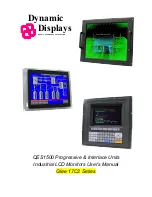
1730–Series Introduction
1–6
Table 1–1: Vertical Deflection System (Cont.)
Characteristic
Step
Number
Supplemental Information
Requirement
X5 gain accuracy
±
5%
1 V input signal
9
X5 gain registration
≤
1 major div. of vertical shift from
baseline.
Unmagnified to magnified display
9
Variable gain range
Input signals between 0.8 V and 2 V
can be adjusted to 140 IRE (1.0 V)
display. 160 mV and 400 mV for X5
gain.
9
Position range
1 V signal can be positioned so that
peak white and sync tip can be placed
at blanking level, with the DC RE-
STORER on, regardless of gain
setting.
Applies to calibrated gain positions
only
9
Maximum absolute input level
±
5 VDC + peak AC
Displays in excess of 200 IRE
(1.428 V) may cause frequency
response aberrations.
DC input impedance
Greater than 15 k
W
(unterminated)
Return Loss (75
W
) video inputs
(CH-A, CH-B)
≥
40 dB from 50 kHz to 6 MHz
A and B channels, loop-through
terminated in 75
W
. Input in use or not
in use, instrument power on or off, all
deflection factor settings.
19
Crosstalk between channels
Greater than 50 dB of isolation
between channels. Measured at F
SC
between Channel A, Channel B, and
EXT REF.
Loop through isolation
Greater than 80 dB of isolation
between loop-throughs. Measured at
F
SC
between Channel A, Channel B,
and EXT REF.
PIX MON frequency response
50 kHz to 6 MHz, within 3% of
response at 50 kHz
Terminated in 75
W
14
PIX MON differential gain (50% APL)
Within 1% with a 140 IRE (1.0 V) unit
display
PIX MON differential phase (50%
APL)
Within 1
°
with a 140 IRE (1.0 V) unit
display
PIX MON DC level on output
0.5 V or less into 75
W.
load
No input signal
11
PIX MON intensification (bright-up)
During line select only. Active video of
selected lines has a DC offset of
approximately 180 mV.
PIX MON output impedance
75
W.
(nominal)
PIX MON return loss (75
W
)
≤
30 dB, 50 kHz to 6 MHz
With instrument turned on
19
Input to PIX MON output gain ratio
1:1
±
5% at 15 kHz
11
Summary of Contents for 1730 Series
Page 4: ......
Page 12: ...Contents viii...
Page 17: ...Introduction and Specifications...
Page 18: ......
Page 32: ...1730 Series Introduction 1 14...
Page 33: ...Operating Instructions...
Page 34: ......
Page 62: ...1730 Series Operating Instructions 2 28...
Page 64: ...Service Safety Summary S 2 1730 Series B070000 Above...
Page 66: ......
Page 67: ...Installation...
Page 68: ......
Page 82: ...1730 Series Installation 3 14...
Page 83: ...Theory of Operation...
Page 84: ......
Page 115: ...Checks and Adjustments...
Page 116: ......
Page 159: ...Maintenance...
Page 160: ......
Page 180: ...1730 Series Maintenance 6 20 3 Remove the board by slipping it through the front panel opening...
Page 184: ...1730 Series Maintenance 6 24 Figure 6 8 Repackaging a 1730 Series instrument...
Page 185: ...Options...
Page 186: ......
Page 189: ...Replaceable Electrical Parts...
Page 190: ......
Page 222: ...1730 Series Replaceable Electrical Parts 8 32...
Page 223: ...Diagrams Circuit Board Illustrations...
Page 224: ......
Page 246: ......
Page 247: ...Replaceable Mechanical Parts...
Page 248: ......
Page 255: ...1730 Series Waveform Monitor FIG 1 EXPLODED VIEW A1 A3 A2 A3A1 A10 A11...
Page 256: ...1730 Series B070000 Up...
Page 257: ......
Page 258: ......
















































